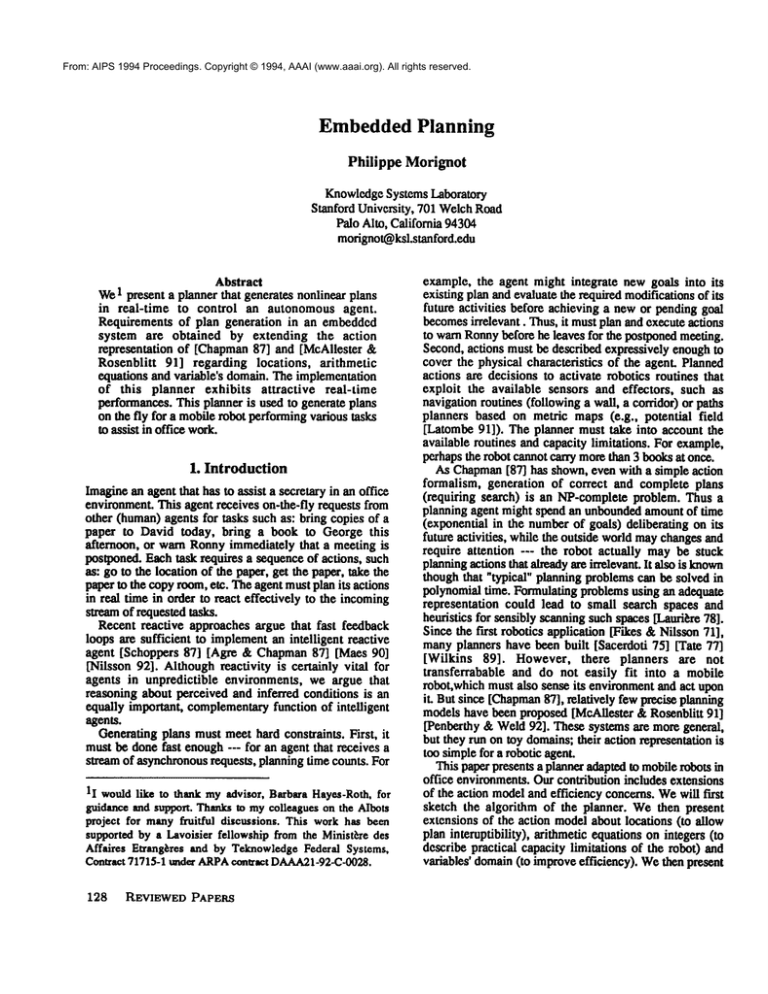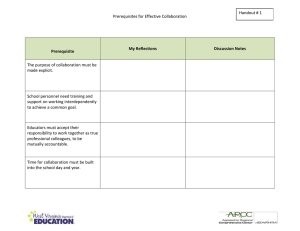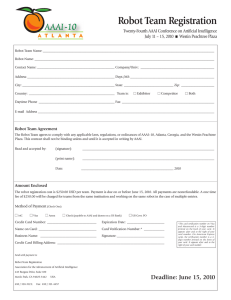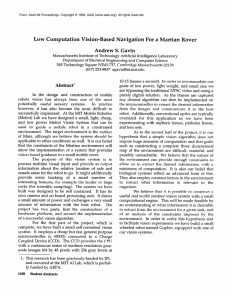
From: AIPS 1994 Proceedings. Copyright © 1994, AAAI (www.aaai.org). All rights reserved.
Embedded Planning
Philippe
Morignot
KnowledgeSystemsLaboratory
Stanford University, 701 WelchRoad
Pale Alto, California 94304
morignot@ksl.stanford.edu
Abstract
WeI present a planner that generatesnonlinear plans
in real-time to control an autonomous agent.
Requirements of plan generation in an embedded
system are obtained by extending the action
representation of [Chapman87] and [McAilester &
Rosenblitt 91] regarding locations, arithmetic
equations and variable’s domain.Theimplementation
of this planner exhibits attractive real-time
performances.This planner is used to generate plans
on the fly for a mobilerobot performingvarious tasks
to assist in office work.
1. Introduction
Imaginean agentthat has to assist a secretaryin an office
environment.This agent receives on-the-fiy requests from
other (human)agents for tasks such as: bring copies of
paper to David today, bring a book to George this
afternoon, or warnRonnyimmediatelythat a meeting is
postponed.Eachtask requires a sequenceof actions, such
as: go to the location of the paper, get the paper, take the
paper to the copyroom,etc. Theagentmustplan its actions
in real time in order to react effectively to the incoming
streamof requestedtasks.
Recent reactive approaches argue that fast feedback
loops are sufficient to implementan intelligent reactive
agent [Schoppers 87] [Agre & Chapman87] [Maes 90]
[Nilsson 92]. Althoughreactivity is certainly vital for
agents in unpredictible environments, we argue that
reasoningabout perceived and inferred conditions is an
equally important, complementary
function of intelligent
agents.
Generatingplans mustmeet hard constraints. First, it
mustbe donefast enough--- for an agent that receives a
streamof asynchronousrequests, planningtime counts. For
II wouldlike to thank myadvisor, BarbaraHayes-Roth,for
guidanceandsupport. Thanksto mycolleagueson the AIbots
project for manyfruitful discussions. This workhas been
supportedby a Lavoisier fellowshipfromthe Minist~redes
Affaires Etrang~:resand by Teknowledge
Federal Systems,
Contract71715-IunderARPA
contract DAAA21-92-C-0028.
128
REVIEWED
PAPERS
example,the agent might integrate newgoals into its
existing plan andevaluatethe requiredmodificationsof its
future activities before achievinga newor pendinggoal
becomesirrelevant. Thus,it mustplan and executeactions
to warnRonnybefore he leaves for the postponedmeeting.
Second,actions mustbe described expressivelyenoughto
cover the physical characteristics of the agent. Planned
actions are decisions to activate robotics routines that
exploit the available sensors and effectors, such as
navigationroutines (followinga wall, a corridor) or paths
planners based on metric maps(e.g., potential field
[Latombe91]). The planner must take into account the
available routines and capacity limitations. For example,
perhapsthe robot cannotcarry morethan 3 booksat once.
As Chapman
[87] has shown,even with a simple action
formalism, generation of correct and complete plans
(requiring search) is an NP-completeproblem. Thus
planning agent mightspend an unboundedamountof time
(exponentialin the numberof goals) deliberating on its
future activities, while the outside worldmaychangesand
require attention --- the robot actually maybe stuck
planningactionsthat alreadyare irrelevant. It also is known
thoughthat "typical" planning problemscan be solved in
polynomialtime. Formulatingproblemsusing an adequate
representation could lead to small search spaces and
heuristics for sensiblyscanningsuchspaces[Lauri~re78].
Since the fn’st robotics application[Fikes &Nilsson71],
manyplanners have been built [Sacerdoti 75] [Tare 77]
[Wilkins 89]. However, there planners are not
transferrabable and do not easily fit into a mobile
robot,whichmustalso sense its environmentand act upon
it. But since [Chapman
87], relatively fewprecise planning
modelshave been proposed[McAllester&Rosenblitt 91]
[Penberthy & Weld92]. Thesesystems are moregeneral,
but they run on toy domains;their action representationis
too simplefor a roboticagent.
This paperpresentsa planneradaptedto mobilerobots in
office environments.Ourcontributionincludes extensions
of the action modeland efficiency concerns.Wewill first
sketch the algorithm of the planner. Wethen present
extensions of the action modelabout locations (to allow
plan inleruptibility), arithmeticequationson integers (to
describe practical capacity limitations of the robot) and
variables’ domain(to improveefficiency). Wethen present
From: AIPS 1994 Proceedings. Copyright © 1994, AAAI (www.aaai.org). All rights reserved.
heuristics and describe experimentswith a mobilerobot on
different scenarios.Finally, webriefly sumup our results.
2. Algorithm
The planners algorithmtakes as input an emptyplan (the
planningproblem)andattempts to producea solution plan.
Usinga robotics analogy, on each cycle, the algorithm
considersthe current plan with its softwaresensors, makes
a decisionwithits heuristics, andmodifiesthe planwith its
softwareeffectors. Wedescribethese three algorithms--- it
is assumedthat the reader is familiar with [Chapman
87]
and [McAllester&Rosenblitt 91].
2.1. Generating Plans
The following algorithm is used to generate a plan
composedof actions P, of unification constraints U, of
temporal orderings O amongactions. Given an initial
situation initial,
a final situation finish
anda setof
actions
schemas
T.GeneratePMn
isinifi~y
c,tled
withthe
arguments({ initial.finish]
~.[(initi al
f i nish)}.T,
depth)
---depth
isthemaximal
number
plan modifications. To preserve the uniformity of
representation, initial (reap., final) constitutes the
effects(reap., prerequisites)of a virtualinitial (reap., final)
action.
~rmzatet’ 1 an(P, U, O, T, d)
1. For every prerequisite g of actions of P, evaluate
mtc(g.
P.U.0).
2. (Solution-Plan)
If all prerequisitesare satisfied, return
the plan (P, U, O).
3. For every unsatisfied prerequisite g, compute
Satis
fyGoal(g.
P, IT,O,T).
4. Rate each pair (unsatisfied prerequisite, plan
modification)
5. Takethe highestrated plan modificationandexecuteit
by modifyingP, U and/or O to P’, IT and/or O’ [while
keeping the other plan modifications for future
backtracking].
6. (Recursive Call) If the number of calls to
OeneratePian reaches the depth d, then backtrack,
othe~vi~
callGenerat
ePlan(F,
U",O’,T, d).
The GeneratePlan
I~ecodm~
is essentially a depthfirst searchin the spaceof plans. It first checkswhethera
solution-planis reachedby computingthe truth value (mtc
algorithm) of every prerequisite (line 1 and 2).
GeneratePlan
then considers the possible plan
modifications (Sat is fyGoal algorithm) of these
unsatisfied goals (line 3), rates themaccordingto its
heuristics (line 4)and executesthe best plan modification
for the best goal (line 5). Then GeneratePlan
re.cursively called if the maximaldepth d has not been
reached.
The plan modifications include action addition
(renaming the variables of an action schemaof T and
adding it to P), (non-)unification addition (adding
constraint (u = v) or (u # v) to U, with u and v
variables of U) and time ordering addition (adding
precedenceconstraint (al < a2) to O, with al and a2 two
actions of P) -- thus unifw~ztion,separation,promotion
and
demotionare represented [Chapman
87].
To preservecompleteness(i.e., finding a solution when
there is one), the depthof the searchis bounded
(parameter
d) and a stack of possible / executedplan modificationsis
maintained(line 5): backlrackingcan then oecm"and lead
to search on other branches.Thedepth is increased if no
solution is foundwithina given depth. Thenumberof calls
toGeneratePlan
(line 6) is measuredby the length
th~becktmck
stack
---empty
backtrack
frames
amallowed
in line 5.
2.2. Observing PLans
Themtcalgorithmchecksthat a l~erequisite g is satisfied
in a plan (P, U, O) for all instantiations of variablesof
andfor all total orders compatiblewith O. It uses a modal
truth criterion: in a plan (P, U, O), a prerequisite g
necessarilytree iff it is necessarilyestablishedin (P, U,O)
andiff eachtimethere is a potential effect c (a clobberer)
that clobbersg, there is an interveningaction w(a whiteknight) that clobbersc andthus rescuesthe truth valueofg
in (P, U, O) --- see [Chapman87] for the rigorous
formulation.
Sincethe planis also modifiedaccordingto this criterion
(see next section), this planneris correct --- a generated
planactuallyis a solutionto the initial planningproblem.A
secondinteresting propertyof this criterion is that for each
prerequisite, it computesthe set of possible / necessary
establishers andthe set of possible/ necessaryclobberers
(see nextsection).
Its main drawback(ap~ from those noted in [Pedmmk
91]) is its high complexity, O(n3) with n the numberof
actions of P --- for example,avoidingthis computational
cost is one raison d°~tre of SNLP’ssystematicity. The
complexityof the global algorithmcan be reduced,though,
with the followingproperty:
Pronertv1: For a particular prerequisite of an action,
thenumber
oftimes.the
modal
wuthcriterion
needs
tobe
called
depends
onthenumber
ofactions
in the(future)
solution-plan
only,
Proof
(sketch):
Toseethis,
first
notice
that
theagent
will
beinterested
inexecutable
plans
---fully
instantiated
and
linear
plans,
This
means
that
thenxxlality
ofthetruth
value
of prerequisites mustbe necessity: a prerequisite mustbe
true for all variables’instantiationsandfor all total orders
amongactions. Secondly, remember that the plan
modificationoperations are action addition, unification
addition, non-unification constraint addition and time
orderingaddition.If a prerequisiteholdsfor all variables’
instantiations, it holdsafortiori for the onespecifiedin a
plan modification like unification or non-unification
addition. Similarly, if a prerequisite holds for all total
orders, it holds afortiori for the one specified by a plan
modificationlike an orderingaddition. Thereforethe only
]~ORIGNOT
129
From: AIPS 1994 Proceedings. Copyright © 1994, AAAI (www.aaai.org). All rights reserved.
plan modification that might changea necessary truth value
of a prerequisite is action addition ~1
Conversely, effects of a newly introduced action might
clobber previously satisfied prerequisites while its own
prerequisites
might be unsatisfied
(the number of
unsatisfied prerequisites increases), its effects might not
change previously satisfied
prerequisites
and its
prerequisites might be already satisfied (the numberof
unsatisfied prerequisites decreases). Therefore regressing
the mtc on the action schemas themselves is needed to
predict some changes made by an action addition to the
Iruth value of prerequisites [Knoblock90].
Thus, the number of times the mtc must be called does
not depend on the number of calls to GeneratePlan --and not, in particular, to promotion, demotion,unification
of separation. Thus, line 1 of GeneratePlan can be
changed, while preserving completeness, to evaluate
mt c(g, P, U, O) only if an action addition has been
performed in the last plan modification. This additional
condition is checked by considering the label of the
topmost frame of the stack of plan modifications (kept in
llne 5 of GeneratePlan).
2.3, Modifying Plans
The SatisfyGoal
algorithm returns a list of descriptions
of all possible plan modificationsthat satisfy prerequisite g
in a plan defined by (P, U, O) and by using the action
schemas T:
Satis£yGoal(g,
P, U, O, T)
Let E ffi (Eposs,Enec)the set of possible and necesssary
establishers of g. Let C ffi (Cposs, Cnec) the set
possible and necessary clobberers of g.
1. (Establishment)If Enecffi
1.a. If Eposs~ ~, for all establishcr e in Eposs, return
the missingconstraints (e = g) and/or (e <
l.b. Otherwise, for all possible establishex from the
set of action operators T, instantiate it into an action
¯ andreuEnSatisfyGoal~g,
P u {e},U, O, T).
2. (Declobbering) If Cposs ~ ~, for all clobberer c of
Cposs, return the constraints g < c and/or g ~ c
(promotionand/or separation).
3. Otherwise, if Cnec~e e, for all clobberer c of Cnec,
do:
3.a. If Eposs~ ~, then for all establisher w of Eposs
such that not(w < c), return unification constraints
such that (w = g) in U u {g = c}, and/or ordering
constraints such that c < w and w < g.
3.b. Otherwise, for all possible establisher from the
set of templates, instantiate it into an action of P and
SatisfyGoal~,
P u {e}, U, O, T).
SatisfyGoallooks for an cstablisher of g, either
existing (line 1.a) or new (line 1.b). It also looks
avoidableclobberers (line 3.a), or for existing (line 3.a)
new (line 3.b) white-knights --- white knights are
establishers with additional consWaints,thus are searched in
Eposs and Ene~ (which are already computed by the mtc
algorithm). This algorithmis called until it returns no plan
130
REVIEWED
PAPEKS
modification.
A plan modification
returned by
S a t i s f y G o a i can be a combinationof primitive ones,
but is alwaysexplicit --- for the condition, derivated from
property 1 above, to be Iriggerable.
3. Action
Language
Following [Fikes & Nilsson 71] and [Pednault 86], an
action is expressed as prerequisites,
effects and
preservation conditions --- conditions that must hold during
the action execution (e.g., (non-)unification constraints).
Addedand retracted effects arc represented uniformly by
addinga sign to literals: positive for addition, negative for
retraction. The action formalism is extended regarding
locations, arithmetic equations and possible objects.
3.1. Locations
In traditional planners, a motion is represented by an
operator schema (MOVE?point-A?point-B); it is
essentially composedof one prerequisite, stating that the
robot was there, and two effects, one that states that the
robot is here now,and another one that states that the robot
is not there any longer. Then an executable plan is a
sequenceof MOVE
actions and static ones (e.g., lake a book
from Michelle, moveto David’s office, give the book to
David). Althougha motion can be represented this way in
our planner, such a MOVE
action is not desirable in a
mobilerobot for the following reasons.
¯ Movingconstitutes the main activity of a mobile
robot. Other componentsof the agent (e.g., path planners,
navigation routines) completely rely on correct locations
[Latombe91] --- giving thema wronginitial location leads
to an erratic motionof the robot.
¯ The current plan of the agent can be interrupted by
another plan that achieves a more urgent task (e.g., the
phone is ringing, therefore a plan is quickly generated to
answer the phone). Thus the execution of the interrupted
plan mayresumefrom a different location.
¯ Using a planner to perform a path search on a
topological mapis inefficient, when comparedto other
dedicated search methods[Latombe91].
To fulfil these requirements, each action of the plan is
considered as an intentional action that might happenat an
intended location: our planner does not use any F~VE
action schema; the location of an action is stored in a
particular field of the action (":location") and can be bound
to variables of prerequisites. Actions that can be performed
at any location (e.g., sending an email) are considered
occur at a location called anywhere.
This use of intentional actions relies on the following
assumption:it is alwayspossible for the robot to moveto a
different place without changingthe structure of the plan.
This is true in the indoor environmentin our scenarios. But
consider an outdoor environment where distance tasks
might be required: if I want to ski at lake Tahoe this
weekend, which is 200 miles away from San Francisco, I
will have to add actions such as filling up the tank of my
From: AIPS 1994 Proceedings. Copyright © 1994, AAAI (www.aaai.org). All rights reserved.
car and driving. These two actions only dependon the
distance from here to lake Tahoe--- if I lived in a ski
resort, I wouldonly haveto walkto the lifts, withouttaking
mycar. Althoughthe previous assumptionholds in our
case, weare currentlyinvestigatingthis reasoningwith the
integer rewesentation(see next section).
To specify a location for eachaction, a topologicalmap
of the environment
is stored in the initial situation and a
prerequisite of each action matcheswith that map. For
example, the action (TakeDocument
?dec?person
?location
?space-left)
contains a prerequisite
(AT ?person ?location)
and the variable
?location is put into the location field (see below).
Since the agent does not moveany personat planningtime,
tbe topologicalmapis not cbangedby the plan.
To optimize the path of a (nonlinear) solution-plan,
actions involving the same location are regrouped by
addingtime orderingconstraints: if action A1 (at location
L1) immediatelyprecedes action A2(at location L2)
L1ffi L2, then consider all actions A3(L3)such that
L2and non-deterrainistieally addconstraint A2< A3or A3
< AI. (Choosingwhichone relies on the global evaluation
function of distance minimization.) Since Chapman’s
declobbering by WhiteKnight clause (see mtc in 2.2.)
wouldbe sure to generatelonger paths (actually actions A1
and A2are performedwithout any motion of the robot),
this rule can be considered as an adaptation of SNLP’s
threat removaloperationto our location representation.
3.2. Capacity limitations
Representingnumbersis difficult in planningtraditional
planners,because(1) literals in prerequisite/effectare only
(possibly negated) relations amongconstants
placeholders, and (2) li ttle in crease in theacti on
formalismleads STRIPS-like
plannersto generateincorrect
plans ~ifschitz 86]. But consider, for example,a mobile
robot that can carry no morethan 3 documents
at a time: if
it is ~L~ked
to carry a fourth document,
it will haveto put
one of h~eothers downand then deliver at least oneof the
three it is holdingbeforecomingbacklater to retrieve the
dropped document. In this case, the existence of two
actions (putting downa document,comingback later to
grab it) onlydependson this capacitylimitation.
Integers can be representedby iterating a symbolin a
literal and by including the occur check clause in the
unification algorithm of the planner. The integer n is
encodedas (+3. (+3. ... (+1 0) ...)) with0
(constant) symbol,+ 1 a symbol(positionally used as
function) whichis iterated n times over 0. Capacity
limitations can then be representedby using counters: For
example, the TakeDocument action schema has
(NumDocSpaces (1+ ?space-left) as a
prea~.uisite,
and(NumDocSpaces
?space-left)
an effect:
thus the counter NumDocSpaces
decrementedby one whenthe action is executed[Jacopin
93]. Switching the two expression wouldincrementthis
counter. As an illustration, the followingaction schema
states that the robot can take a document?dec from
7person
at? location,
ifthere
still
atMastonespace
left
(?s 1 ) onthe
robot:
(deftemplate(TakeDocunex~
7dec ?person?location?sl)
:prerequisites
( ( :NOT(holdRobot?dec)
(hold.~person?dec)(at ?person?location)
:preservations
( ((i+
:NOT
( :ffi9person
Rdoot
(NumDocSpaoes
?sl)
") )
:effects((holdrobot?dec)(:NOT (hold?personl~]oc))
(:NOr (NumDocSpaces
(I+ ?sl)))(NumDocS~aces
:location
?location)
The maximalnumberof documentsthat can be carried at
onceby the robot (3 in our initial example)is specified
an effect in the initial situation: (NumDocSpaces
(l+
(l+ (I+ 0)))).
Arithmetic
equationssuchas "x ffi y 4. constant"and"x ffi
y - constant" are maintained by using unification
constraints amongcomposite variables --- a plan
modification
such as (= (NumDocSpaces ?x)
(NumDocSpaces(3.+ (i+ (I+ ?y) ) ) ) )
the equation "?x = ?y + Y relating to the NumDocSpaces
relation. Thefour basic arithmeticoperations,for example,
can bencodedthis wayin our planner.
3.3. Domains
To copy a documenton slides, the robot might knowin
advancethe possible locations whereslides can be found.
Werepresent this knowledgeas a domainof the variables
used by the planner. Anadvantageof this is that passing
constraints around might quickly reduce the domainof
somevariables and thus lead to fast instantiations --- a
constraintsatisfaction viewof searchspacereductionin the
p!anningprocess.
A domainof a variable is stated as follows: Whena
prerequisiteis establishedbyseveral effects of the virtual
initial action usinga unificationconstraints, andwhenthe
samevariable appearsin all these constraints, these plan
modificationsare consideredto define a domainfor that
sharedvariable. Anexampleof this is type definition: the
unaryrelation ST.TDE
mightdefine the available slide pads
iff (1) the initial situation includes (SLTDE
(SLTDE $2) (SLIDE S3) and (2) no action schema
creates slides --- no constantcreation aboutthis relation.
Then the prerequisite (SLZDE ?S) can be satisfied by
plan modifications. The previous rule then defines (S
S2 S 3) as a domain for ? S. The separation plan
modificationwill then removevalues from domains;When
there is only onevalueleft in a domain,this valuewill be
taken as the value of the corresponding variable.
Practically, it involves sequentially performingtwo plan
modifications (line 5 of GeneratePlan):
a unification
constraint right aftera non-unificationone.
Twocaveats mustbe stated though: First, contrary to
typical Constraint Satisfaction Problems,a variable’s’
domain might be augmented --- an action might be
addedbefore
a prerequisitethat definesa variable’s domain,
after that domainis definedduring the planningprocess.
MORIGNOT
131
From: AIPS 1994 Proceedings. Copyright © 1994, AAAI (www.aaai.org). All rights reserved.
Inferring a variable’s value with the last value of a domain
might then lead to early instantiations.
Therefore we
assumethat no constant is created on the fly by an action
schema. In our application, it means knowingin advance
all the possible objects the agent might haveto deal with --whichis reasonable. Second,since the modaltruth criterion
does not involve variables’ domains, a prerequisite might
be considered to be true by considering domains, whereas
the mtc algorithm would return false --- as noted in
[Chapman87]. It is not clear though howmuchefficiency
would be gained by such an additional reasoning. Our
experiments with variables’ domains on real cases (see
section 5.3.) prove that substantial performances can
already be reached.
4. Heuristics
The performance of the planner depends on the order in
which unsatisfied prerequisites and plan modifications are
selected. The rating of plan modifications (line 4 of
GeneratePlan)
usesthefollowing
heuristics:
¯ Delay action addition as long as possible. This
heuristic proposes to add an action only whenthere is no
other way to satisfy a prerequisite. Intuitively, all the
relevant information should be extracted from a plan before
adding new actions. Given property 1, this heuristic also
avoids high branching factors.
¯ lnstantiate a variable whenthere is one value only.
This heuristic proposes to take a value when there is
actually no other one. It is based on the use of previously
described domainsand assumesthat even if that variable is
not instantiated, going further into the planning process
wouldnot create a secondvalue for this variable.
¯ Solve local conflictsfirst. This heuristic proposesto
sort conflicts by increasing the distance clobberer /
prerequisite
(measured in the number of actions).
Intuitively, local conflicts might interfere with long
conflicts, and considering their resolution locally might
have fewerpossibilities.
5. Real Agent
5.1. Domain
A planner, including the previous features and based on
[Morignot 91], has been implemented 1 to control a
Nomadies 200 mobile robot [Zhu 92]. The modeled agent
must perform some tasks requiring
motion and
communication in an indoor environment (actually the
corridors and offices of the first floor of the K.S.L.).
Physically, the robot can rotate its wheels, change their
direction, rotate a turret that supports a CCDcamera for
imagerecognition, and use a voice synthetizer. Its sensors
include 16 sonars, 18 infra-rcd, 18 bumpers and 1 laser
1 The source-codeis available by request to the author.
132
REVIEWED
PAPERS
with itsassociated (second) CCDcamera. Sensors and
effectors are controled by an on-board PC 486 or by a
remote workstation via a radio modem.
In the first scenario, the robot has to survey a level of an
office building and respond to alarms (e.g., phoneringing,
broken window,open door) according to their natttre and
urgency. A second set of scenarios involve assisting a
secretary with tasks such as delivering documents,copying
papers, sending entail or verbally warningpeople.
5.2. Monitoring
The agent monitors the execution of its current plan by
movingthe virtual initial action ("now")forwardin time:
1. Accordingto its actual state and needs, the agent
chooses one action to he the nextvirtual action. If needed,
a precedence constraint is put betweenthis chosen action
and its siblings (related to the virtual initial action).
2. The action chosen for execution is removedfrom
the plan. Effects of this action are added to those of the
virtual initial action, previous effects of the initial action
that are mentionedinthe chosen
action are removed(their
truth value changes or is subsumedby one specifiedby a
neweffect).
3. Thechosenaction is sentto robotics routines of the
robot for actual control of the sensors and effectors.
The present document focuses on the plan generation
capability: For moredetails about the general role of plans
and intentions in the overall agent architecture, see [HayesRothet al. 93].
$.3. Performances
This planner is used in two sets of scenarios (an alarm
domain, an office factotum domain) and has been tested in
standalone on other domains: blocks domain, towers of
Hanoi. Tests were carried out on a SpacStation 10 using
Lucid Common-Lisp4.1 and a source-code compiled in
developmentmode(see table 1).
Domain
Time
Actions
Cycles
Blocks
0.17
3
10
Hanoi
0.70
7
29
Alarm
0A2
5
12
Office
0.37
6
17
Table
1: Performanceof the planner.
Although performances get worse as the problem size
increases, plan generation in ~ cases (i.e., actually
happening in our scenarios) takes less than one second in
real time.
Asa secondresult, the solution plans are usually close to
the root of the search space (less than 30 plan
modifications, including less than 10 action additions).
Thusdepth-first search is appropriate to represent p/ann/rig
choices: it has been reported for examplethat chess players
explore a single path at ever greater depth and repeatedly
return to the initial state [de Greet 65].
In practice, given that the maximalspeed of the robot is
roughly 10 inches per second, the world modelmight he at
most 10 inches inaccurate betweenthe start and the end of
From: AIPS 1994 Proceedings. Copyright © 1994, AAAI (www.aaai.org). All rights reserved.
the plangenerationprocess.That’sactually
half the size of
the robot itself, andthe navigationroutines of the robot
alreadykeepa half diametersecurity interval distancefrom
knownobjects.
A
0
,5
10
15
20
~q
30
Figureh Size of the searchspace.
Toillustrate the waythis plannerscansthe searchspace,
weconsider the pons asinorumin planning, the towers of
Hanoi.Toevaluate the shapeof the search space, fig,the 1
showsthe branchingfactor of Gene2:ateP].an (i.e., the
numberof plan modifications)as a function of the number
of recursive calls (i.e. the planner’s cycle). First, the
branchingfactor is not constant during plan generation
(meanffi 6.1, variance = 6.8): Eachmaximum
corresponds
to an action addition,the prerequisitesof whichare usually
not satisfied (mainlybecauseof fresh variables to bind).
Betweentwo action additions, heuristics 2 and 3 add
constraints to the plan, whichis guaranteednot to increase
the branchingfactor (according to pm~rtyI). Whenthese
two heuristics cannot be triggered, the plan is either a
solution(as in cycle29) or heuristic 1 is triggeredagain
generate a newmaximum
(as in cycle 1, 3, 8, 13, 16, 20,
26). As a result, the exampleof figure 1 is carried out
withoutbacktracking.Whatis surprising,though,is the fast
decrease right after a maximum--- more than one
prerequisite is satisfied with one plan modification.Thus
previous heuristics choose to execute the plan
modifications that satisfy the largest number of
prerequisitesto keepthe branchingfactor low.
6. Conclusion
A plannerthat successfullygeneratesplans in real-time to
control an autonomous
agent has been presented. Handling
the practical characteristics of an embedded
systemhas led
us to extend the action model to represent arithmetic
equations,andto considerintentional actions to represent
locations. Efficiency concerns while preserving
completenesshaveled us to represent variables’ domains.
Animplementation
of this planner, that exhibits attractive
empirical real-time performances, is currently used to
generate plans on the fly in an application involving a
mobilerobot in our laboratory. Our ongoingworkfocuses
on representingcollaboration/ competitionamongmultiple
agentsusing motivationsand intentions.
References
Agre, P., and Chapman, D. 1987. Pengi: An
Implementation
of a theory of Activity. In Proceedingsof
AAAr87,
Seattle.
Chapman,D. 1987. Planning for Conjunctive Goals.
Artificial Intelligence32(3):333-377.
de Groot, A. D. 1965. Thoughtand choice in chess. The
Hague: Mouton.
Fikes, R., andNilsson, N. 1971.Strips: AnewApproach
to
the Application of theoremProving to ProblemSolving.
Artificial Intelligence2(3/4):198-208.
Hayes-Roth,B.; Laianda, P.; Morignot,P.; Balabanovic,
M.; Pfieger, K. 1993. Plans and Behaviorin Intelligent
Agents.Tech. Rep. KSL-93-42,
Stanford Univ.
Jacopin, E. 1993.ALookat FunctionSymbols
in Planning.
AAAISpring Symposium
on Planning, Stanford Univ.
Kambhampati,
S. 1992. Characterizing Multi-Contributor
CausalStructures for Planning.In Proceedingsof AIPS’92,
CollegePark.
Knoblock,C. 1990. LearningAbstraction Hierarchies for
ProblemSolving. In Proceedingsof AAAI’90,
Boston.
Latombe,J.- C. 1991. Robot Motion Planning. Kluwer
AcademicPub., Boston.
Lauri~re, J.-L. 1978. A Languageand a Programfor
Stating and Solving CombinatorialProblems.Artificial
Intelligence10(1):29-127.
Lifschitz, V. 1986. On the Semantics of STRIPS.In
Reasoningabout Actions &Plans, Timberline, Georgeff&
Lanskyeds., MorganKaufruann.
Maes, P. 1990. Situated Agentscan have Goals. Robotics
and AutonomousSystems Journal. Special issue on
Designing Autonomous
Agents 6 (1&2).
McAllester, D. and Rosenbliu, D. 1991. Systematic
NonlinearPlanning.In Proceedingsof AAAI~)
1, Anaheim.
Morignot,P 1991.Truth Criteria in Planning.Ph.D.diss.,
C. S. Dept., ENST,Paris. (in French)
Nilsson, N. 1992. TowardsAgent Programswith Circuit
Semantics.Tech. Rep. CS-1412,Stanford Univ.
Pednault, E. 1986. Towardsa MathematicalTheoryof Plan
Synthesis.Ph.D.diss., Elec. Eng.Dept., StanfordUniv.
Pednault, E. 1991. Generalizing Nonlinear Planning to
Handle Complex Goals and Actions with ContextDependent
Effects. In Proceedingsof IJCAI’91,Sydney.
Penberthy, S., and Weld, D. 1992. In Proceedings of
KR’92,Cambridge.
Sacerdoti,, E. 1975. The NonlinearNature of Plans. In
proceedingsof UCAr’75,
Tbilisi.
Schoppers,M. 1987. Universal Plans for Reactive Robots
in Unpredictible Environments. In Proceedings of
UCAI’87,Milan.
Tale, A. 1977. Generating Project Networks. In
Proceedingsof UCAI’77,Boston.
Wilkins, D. 1988. Practical Planning: Extending the
Classical Planning Paradigm.MorganKaufmann.
Zhu, D. 1992. Nomadic Host Software Development
Environment.NomadicTechnologiesInc, MountainView.
MORIGNOT
133






